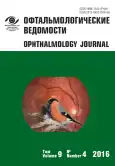Синдром «верхней глазничной щели» вследствие аневризмы внутренней сонной артерии в кавернозном синусе
- Авторы: Астахов Ю.С.1, Марченко О.А.2, Потёмкин В.В.1, Титаренко А.И.1
-
Учреждения:
- ФГБОУ ВО ПСПбГМУ им. И.П. Павлова Минздрава России
- СПб ГБУЗ «Городская многопрофильная больница № 2»
- Выпуск: Том 9, № 4 (2016)
- Страницы: 102-106
- Раздел: Статьи
- Статья получена: 08.02.2017
- Статья опубликована: 15.12.2016
- URL: https://journals.eco-vector.com/ov/article/view/6015
- DOI: https://doi.org/10.17816/OV94102-106
- ID: 6015
Цитировать
Аннотация
Полный текст
Об авторах
Юрий Сергеевич Астахов
ФГБОУ ВО ПСПбГМУ им. И.П. Павлова Минздрава России
Автор, ответственный за переписку.
Email: astakhov73@mail.ru
д-р мед. наук, профессор кафедры офтальмологии Россия
Ольга Анатольевна Марченко
СПб ГБУЗ «Городская многопрофильная больница № 2»
Email: oamarchenko@yandex.ru
врач-офтальмолог Россия
Виталий Витальевич Потёмкин
ФГБОУ ВО ПСПбГМУ им. И.П. Павлова Минздрава России
Email: potem@inbox.ru
канд. мед. наук, доцент кафедры офтальмологии Россия
Александра Ивановна Титаренко
ФГБОУ ВО ПСПбГМУ им. И.П. Павлова Минздрава России
Email: titarenko@yandex.ru
клинический ординатор, кафедра офтальмологии с клиникой Россия
Список литературы
- Пономарев В.В., Барановский А.Е., Сытый Ю.В., Живолупов С.А. Каротидные артериальные аневризмы, симулирующие синдром Толоса — Ханта // Неврологический журнал. – 2014. – Т. 19. – № 5. – С. 13–21. [Ponomarev VV, Baranovskiy AE, Sytiy YuV, Zhivolupov SA. Carotid arteries aneurysms masquerade as Tolosa-Hunt syndrome. The Neurological Journal. 2014;19(5):13-21. (In Russ.)]
- Bars HW, Blackwood W, Meadows SP. Intracavernous carotid aneurysms. A clinical-pathological report. Brain. 1971;94:607-22. doi: 10.1093/brain/94.4.607.
- Bavinzski G, Killer M, Ferraz-Leite H. Endovascular therapy of idiophatic cavernous aneurysms over 11 years. Am J Neuroradiol. 1998;19:559-65.
- Drazin D, Choulakian A, Nuno M, et al. Improvement in Visual Symptomatology after Endovascular Treatment of Cavernous Carotid Aneurysms. J of Vascular and Interventional Neurology. 2013;6:15-21.
- de Vasoncellos LP, Flores JA, Veiga JC, et al. Presentation and treatment of carotid cavernous aneurysms. Arq Neuropsiquaitr. 2008;66:189-193. doi: 10.1590/S0004-282X2008000200009.
- Eddleman CS, Hurley MC, Bendok BR, et al. Cavernous carotid aneurysms: to treat or not to treat? Neurosurg Focus. 2009;26(5): E4. doi: 10.3171/2009.2.FOCUS0920.
- Evans HH, Wurth BA, Penna KJ. Superior Orbital Fissure Syndrome: A Case Report. Craniomaxillofac Trauma Reconstruction. 2012;5:115-120. doi: 10.1055/s-0032-1313363.
- Goldenberg-Cohen N, Curry C, Miller NR, et al. Long term visual and neurological prognosis in patients with treated and untreated cavernous sinus aneurysms. J Neurol Neurosurg Psychiatry. 2004;75:863-867. doi: 10.1136/jnnp.2003.020917.
- Hahn CD, Nicolle DA, Lownie SP, et al. Giant Cavernous Carotid Aneurysms: Clinical Presentation in Fifty-seven Cases. Journal of Neuro-Ophthalmology. 2000;20(4):253-258. doi: 10.1097/00041327-200020040-00010.
- Kai Y, Hamada J, Morioka M, et al. Treatment strategy for giant aneurysms in the cavernous portion of the internal carotid artery. Surgical Neurology. 2007;67:148-155. doi: 10.1016/j.surneu.2006.03.037.
- Lakke JP. Superior orbital fissure syndrome: Report of a case caused by local pachymeningitis. Arch Neurol. 1962;7:289-300. doi: 10.1001/archneur.1962.04210040041004.
- Lenzi GL, Fieschi C. Superior Orbital Fissure Syndrome. Eur Neurol. 1977;16(1-6):23-30. doi: 10.1159/000114876.
- Linskey ME, Sekhar LN, Hirsch WL, et al. Aneurysms of the Intracavernous carotid artery: natural history and indications for treatment. Neurosurgery. 1990;26:933-938. doi: 10.1227/00006123-199006000-00002.
- Menon, et al. EC-IC bypass for cavernous carotid aneurysm. Asian Journal of Neurosurgery. 2014;9(2):84-85. doi: 10.4103/1793-5482.136718.
- Morris P, ed. Practical Neuroangiography. 3rd ed. Lippincott Willis & Wilkins; 2013. P. 279-84.
- Postma MP, Seldomridge GW, Vines FS. Superior Orbital Fissure Syndrome and Bilateral Internal Carotid Pseudoaneurysms. J Oral Maxillofac Surg. 1990;48:503-508. doi: 10.1016/0278-2391(90)90241-S.
- Rai S, Rattan V. Traumatic superior orbital fissure syndrome: Review of literature and report of three cases. National Journal of Maxillofacial Surgery. 2012;3(2):222-225. doi: 10.4103/0975-5950.111392.
- Reymond J, Kwiatkowski J, Wysocki J. Clinical anatomy of the superior orbital fissure and the orbital apex. J Craniomaxxilofac Surg. 2008;36:346-53. doi: 10.1016/j.jcms.2008. 02.004.
- Rohrich RJ, Hackney FL, Parikh RS. Superior orbital fissure syndrome: current management concepts. J Craniomaxxilofac Trauma. 1995;1(2):44-48.
- Rosi JJ, Willing LC, Yeng LT, et al. Cavernous carotid artery aneurysms: Epidemiology, natural history, diagnostic and treatment. An experience of a single institution. Clinical Neurology and Neurosurgery. 2014;125:32-35. doi: 10.1016/j.clineuro.2014.07.015.
- Stiebel-Kalish H, Kalish Y, Bar-On RH, et al. Presentation, Natural History, and Management of Carotid Cavernous Aneurysms. Neurosurgery. 2005;57:850-857. doi: 10.1227/01.NEU.0000179922.48165.42.
- Wiebers DO, Whisnant JP, Huston J III, et al. Unruptured intracranial aneurysms: natural history, clinical outcome, and risks of surgical and endovascular treatment. Lancet. 2003;362:103-110. doi: 10.1016/S0140-6736(03)13860-3.
Дополнительные файлы








